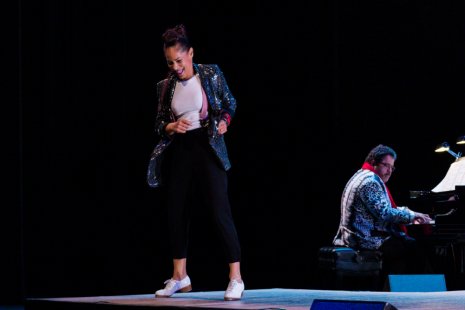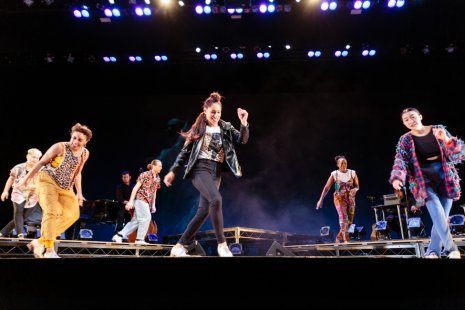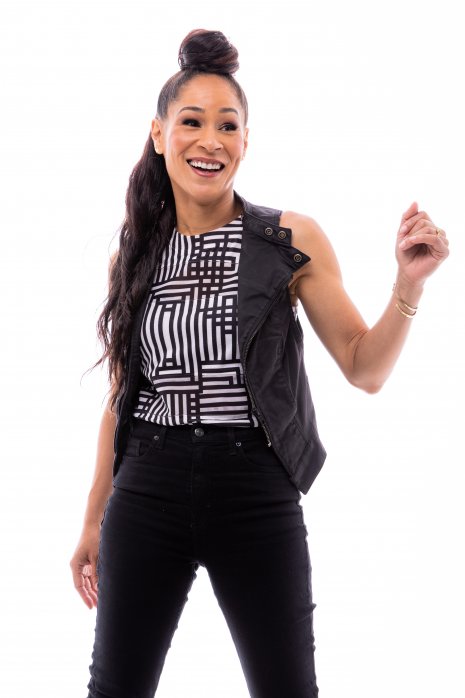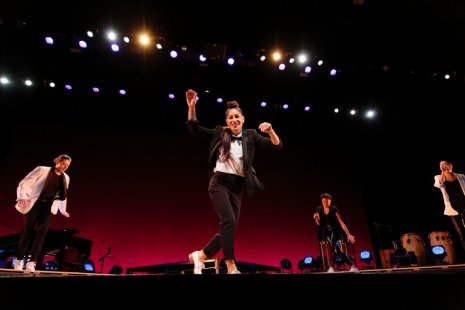In Ayodele's Words...
My mission is to transform how people view and experience the art of tap dancing, and I want to amplify the message by increasing the mediums where my work is shared, expanding the stage to film, television, publications, and brands that reach global communities.
Early in my tap education I discovered the power of tap dancing to tell stories. My entry into tap dancing - as an actor - contributed to my impulse to create work that includes both text and dance. Early in my performance career, I realized something needed to change in how audiences experienced tap dancing. They'd often be complimentary of the technical skill and proficiency tap dancers displayed in performance but walked away with little else. If we presented work in a way that revealed our humanity and gave a window into the ‘why’ of our expression, audiences would see themselves in us, and the tap dancing would be a joyous bonus. In 2005 I explored this concept in presenting my first "Diary of a Tap Dancer" installation. The piece was vulnerable but transformative. My creative exploration expanded in its effort to illustrate the depth of what tap dancing could achieve.
At the age of 19, at NYU, I took my first tap class. I learned that tap was deeply rooted in communication, personal expression, and connected to a beautiful legacy of Black people in America. I was filled with a desire to be a student of the art for life, and this is the reason that historical context and education are elements in the work. As a young person of color, who didn't see a lot of Black and Brown representation, it filled me with pride in my own cultural and ancestral legacy.
When laws were enacted in this country to remove drums from the hands of enslaved Africans, they transformed those restrictions into physical, percussive music. To me, tap dance is the triumph of the human spirit. That celebration is prevalent in everything I do. I’ve relished conveying its sophistication, elegance, joy, and power to entertain and transport audiences to a musical and emotional world, exploring and celebrating the community created on stage, while also being inclusive of the audience.
The erasure of Black women tap dancers from history has also been a formative experience for me as a woman and an artist. Sharing their stories is a massive influence on the development of my work. As I learned about these women, I was in awe of the parallel within our stories. Everything from their love of the art, who they learned it from, hanging around stage doors, and the experience of being disregarded or overlooked because we were Black women.
I've always been compelled to disrupt the gender stereotypes within the art of tap and live in a way that celebrates the full expression of my identity in life and in art. Edwina "Salt" Evelyn, one of our pioneer tap dancers, lived closeted for 48 years. It is a privilege to live my life openly as a queer woman and celebrate that within my artistic expression with freedom. I do it for myself and those women who didn't feel like they could. If I don't dare to share my history and document my narrative, my story would be no different from that of Lois Bright, Louise Madison, or Juanita Pitts. Obscure, brief, and practically non-existent. I'm determined to change that for myself and urge everyone I interact with to do the same.
In 2019, I spoke at a panel discussion regarding “Decolonizing Dance” and expressed deep concern about the marginalization of tap artists of color in the concert dance world. It was inconceivable to me that Black tap dance artists were receiving such little institutional support to thrive. I expressed passionately that it was imperative to create balance, to accurately reflect the tap cultural landscape. Speaking that truth publicly made me braver, deepening my own creative work while elevating many contemporary tap voices. It brings joy.
Usually, only a single percussive artist gets presented in a seasonal program. Many presenters need to understand that we require an adequate floor surface and proper sound amplification to perform our work successfully. Often, the burden falls on us to provide flooring to facilitate our performances which considerably cuts into the fees provided to the artist. I have strongly advocated for institutions to provide equitable support to percussive artists, and after many years, I finally see the needle inching toward equity...
It took over 20 years, but the FIRST time I experienced absolute freedom as a creator was during my fellowship year at the Radcliffe Institute. I was shocked to learn that working with that kind of financial support was available to me. These resources aren't widely circulated or spoken about in our community. The freedom to create, research, and dream about what's next without worrying about paying my rent was invaluable and life- changing. I have committed to sharing every piece of information I gather with the next generation of dancers I mentor so that their path has more possibility without resistance.
My work is transparent in its messaging. This is not to say that it is simplistic in form, but instead that it wears its heart on its sleeve. Most people who experience my work feel my joy of rhythm, my love of music, and the musicians and dancers with whom I share the stage. The one thing people may not immediately recognize is that I am fiercely committed to the personal and artistic development of young people. Gregory Hines, a mentor, and friend to me, always spoke about how he loved dancing with young people. He remained inspired by their point of view, and he was a fierce supporter of mine and many others. I feel energized by the talent and spirit of younger artists and recognize the importance of mentorship as they explore their artistry. It brings me joy, and it keeps me young.
I am also deeply invested in creating community with the audience, elevating the artistic voices of women of color, and cementing a place for tap dancing in as many spaces as possible. I believe the art sits squarely in the center of social justice, gender, race, popular culture, music, and politics, and would like to eliminate colloquial phrases such as "tap dancing around the subject," and stereotypical connotations that imply submissive behavior lacking integrity or pride.
This period in my life is the most centered and focused with laser vision I have ever felt. I am creating meaningful work and developing relationships with artists and institutions that I love. What I am most thrilled about is that the result is far-reaching. I am excited about the present and future.





